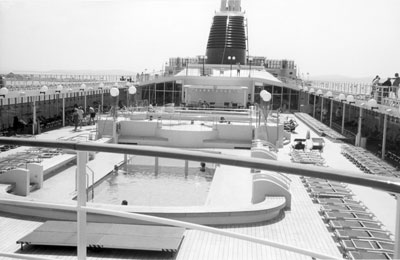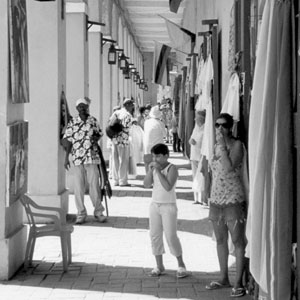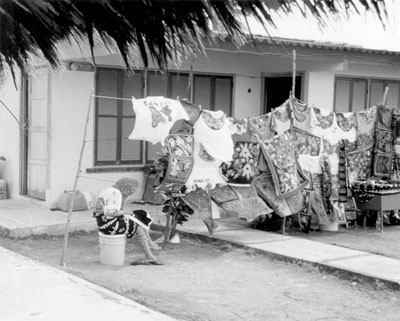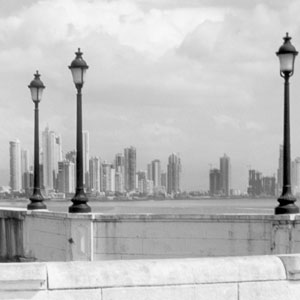Cruising Latin America, European style
by Deanna Palic (second of three parts, jump to part 1, part 2, part 3)
One of the most interesting aspects of our January ’06 MSC Lirica cruise was the opportunity to mingle with passengers of diverse nationalities. French, Spaniards, Italians, British, Dutch, Swiss, Austrians, Germans, Montenegrins, Canadians, Israelis, Puerto Ricans and Venezuelans rounded out the passenger roster. American passengers were primarily from the Midwest and the East Coast.
Shipboard announcements, which are not broadcast into the cabins, were in five languages: Italian, French, English, German and Spanish.
Life on board
Shipboard life can be as full or relaxing as you choose. The MSC Lirica’s resort areas boast two outdoor swimming pools and whirlpools, a spa, a fitness center, a miniature golf course, a jogging/walking track and a relaxation/meditation room. In addition to the library, which stocks books in many languages, there are a shopping gallery, Internet café, casino and hair salon.
In the evening, things liven up with excellent productions in the Broadway Theatre. Once again, introductions are in five languages.
Music continues into the wee hours in the cozy L’Atmosphere Piano Bar or you can dance the night away to Latin music in Le Cabaret. Still wide awake? The Blue Club Disco doesn’t post a closing hour.
Although there is a currency-exchange office on board, we were able to use U.S. currency in every port.
A Hospitality Corner is provided for those speaking the five major languages on board. Each language has a native staff speaker to answer guests’ questions. Hours and location are published in the daily program.
Unusual tipping policy
MSC Cruises handles tipping differently than any cruise line on which I have sailed. The guidelines listed in their brochure, under “Gratuities,” advise that $12 daily is billed to each passenger’s account. Children under 18 who are sharing a cabin with two adults are each billed $8 per day.
These gratuities are distributed to the maître d’, table supervisor, waiters, busboys, buffet staff, cabin attendants, room service, bellboys and bar staff. We found this system agreeable, and the staff seemed happy with it. Nevertheless, we extended a bit extra to those who went above and beyond on our behalf.
MSC goes on to inform its passengers that this policy is discretionary. If you should wish to make adjustments, you may do so by contacting the reception desk at any point during the cruise.
Ports of Call
Each of us has a motive for choosing a particular cruise. Mine is the ports of call. All excursion prices that follow are per person and quoted in U.S. dollars.
Ocho Rios (Jamaica)
One of Jamaica’s most popular attractions is Dunn’s River Falls. MSC’s excursion was priced at $69. The falls consist of clear mountain water flowing seaward across a tiered limestone bed. Running or aqua shoes are needed for the climb over slippery stones and rushing, knee-deep water.
If you prefer to do your own thing, it is an easy one-kilometer stroll into town. Along the way we stopped at Jose’s Bar for an ice-cold beer in the Island Village Shopping Centre.
We then continued to the duty-free Taj Mahal Centre. Check prices at home of items you might wish to purchase duty-free. Then you will know for sure if purchasing duty-free makes sense.
Cartagena (Colombia)
Hot, sultry and filled with the sounds of music and tradition, Cartagena has been an important port on the Caribbean since it was founded in 1533. I found it to be the most fascinating city on the cruise.
Gold and silver left the port bound for Europe, pirates looted the city, and a walled fort grew to protect both shipping and the slave trade. Cartagena’s most noteworthy historical sites are located within the colonial sector of the city.
MSC’s excursion for the Cartagena city tour cost $42. Outside the terminal is a stand to hire registered English-speaking guides and taxis.
We decided to do our own tour, which included both the colonial and modern sectors for $30, and arranged for a tour upon our arrival in the city. If you wish to make arrangements beforehand, I highly recommend the services of the guide we received, María del Socorro Gonzalez (tel. 011-57-5-310-6110943 or 011-57-5-310-3518250 or e-mail mariadel socorro17@yahoo.es). María is a very knowledgeable English-speaking guide, and she will provide the transportation.
San Blas (Panama)
Home to the Kuna Indians, the San Blas Islands stretch along the Atlantic coast of Panama from the city of Colón to Colombia. The archipelago is made up of over 365 islands off the northern coast of Panama plus a strip of land along the Caribbean coast from the province of Colón to Colombia.
This was the only port where we utilized tender service from ship to land. Tender frequency was more than adequate. Only one MSC excursion was offered, the Kuna Indians tour at $40. We took the tender and browsed around Porvenir on our own.
Since my previous visit 30 years ago, TV antennas have sprouted on the thatched roofs of small, dirt-floored Kuna houses made of sticks. San Blas still remains virtually untouched by commercial development.
Molas are wearable art that decorate the women’s blouses. They are hand sewn, using a reverse appliqué technique, and depict ancient designs as well as local flora and fauna. You can purchase molas suitable for framing or sewn into handbags, shirts and hats. They make unusual gifts.
Also for sale were unique bead jewelry and local wood items.
Cristobal (Panama)
Cristobal is Panama’s port on the Caribbean side, and nearby Colón is the world’s second-largest Free Zone. Again, know what you plan to purchase and check prices at home to ensure getting bargains there.
We booked MSC’s “The Best of Casco Antiguo” excursion at $80. As I was aware that the drive to Panama City would be approximately 1½ hours, the price didn’t seem out of line.
The most interesting aspect of this excursion was a visit to the Canal Museum for a photographic history of the canal’s construction. The museum building was originally known as the Grand Hotel, which was destroyed in the 1858 earthquake and rebuilt.
Unfortunately, the colonial part of the city is sadly run-down. We all were disappointed that our only exposure to modern Panama was from a distant viewpoint.
If you should decide to tour Panama City on your own, you can hire a taxi at the pier for $150 for up to three persons. Each additional person costs $50. Arrange beforehand that your driver will include a tour of both old and new Panama.
Coming up, more ports of call: Costa Rica and Honduras.
Deanna Palic paid a discounted media rate for their cabin aboard MSC “Lirica.”




